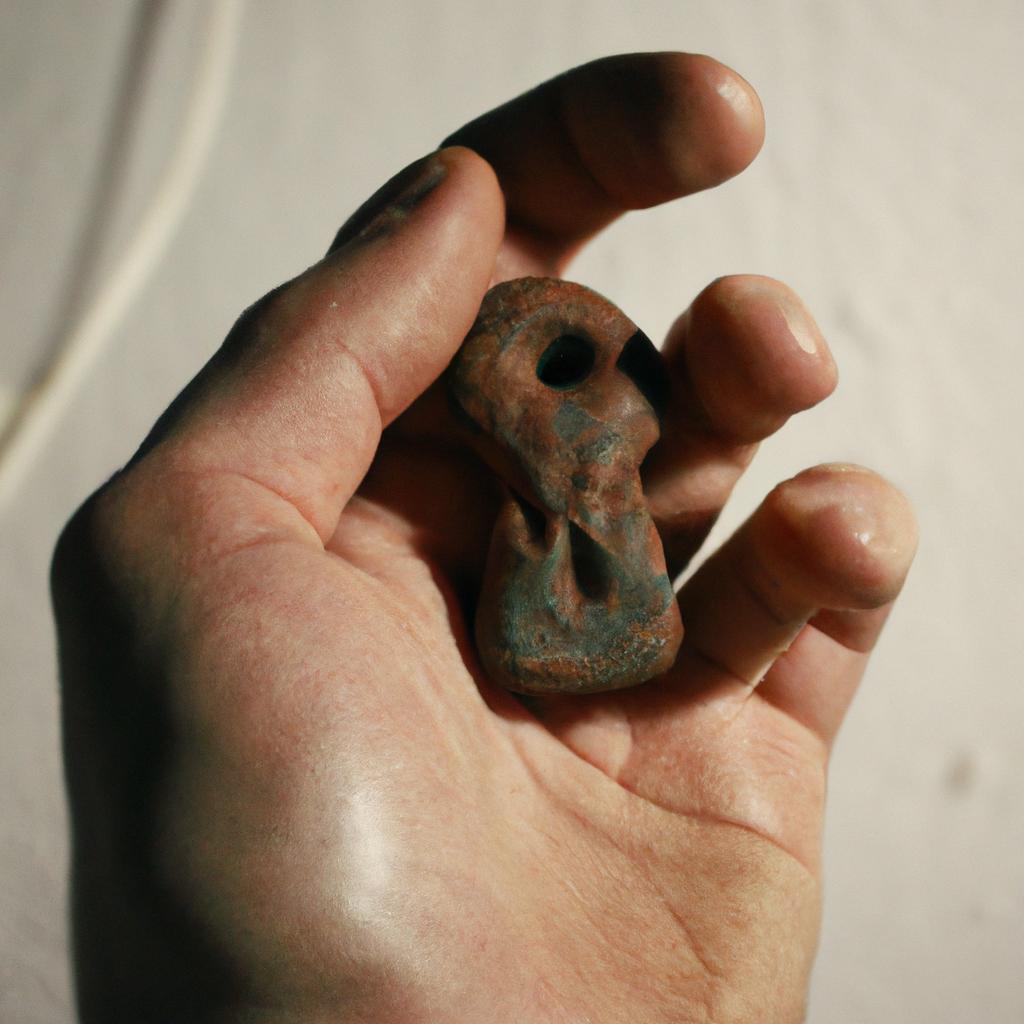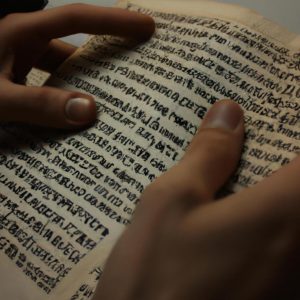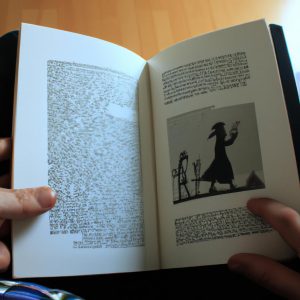Legends Unveiled: The Golem: Ashkenazi Heritage’s Enigmatic Folklore

In the realm of Jewish folklore, one enigmatic figure stands out: the Golem. This legendary creature has captured the imaginations of generations, its origins shrouded in mystery and its purpose steeped in supernatural power. From ancient texts to modern retellings, the tales of the Golem have been passed down through Ashkenazi heritage, leaving an indelible mark on Jewish culture. Exploring this intriguing folklore can shed light not only on the legends themselves but also on the historical and cultural contexts that shaped them.
To illustrate the enduring significance of Golem folklore, consider a hypothetical case study: Sarah, a young woman growing up in a tight-knit Jewish community, hears whispers about a hidden manuscript housing secrets about creating a Golem. Intrigued by these rumors, she embarks on a quest to uncover the truth behind this mythical creature. Through her research and conversations with elders, Sarah uncovers fragments of stories and rituals surrounding the creation and control of a clay monster brought to life by Hebrew incantations. The mysterious allure of these legends compels Sarah to delve deeper into her own heritage as she grapples with questions about faith, power, and identity.
This article aims to delve into the multifaceted layers of Golem folklore, exploring its historical origins, symbolic meanings, and contemporary interpretations. By examining the various aspects of Golem tales, we can gain insights into the complex relationship between humans and supernatural beings in Jewish tradition.
One crucial aspect to explore is the historical context in which Golem legends emerged. The earliest known reference to a Golem can be found in Jewish mystical texts dating back to the Middle Ages. These texts describe rituals and formulas for animating an artificial being made of clay or mud. Scholars believe that these stories were influenced by ancient Mesopotamian myths and later incorporated into Jewish mysticism.
Symbolically, the Golem represents humanity’s desire for control over nature and the search for power. In Jewish folklore, it is often depicted as a servant created by a righteous person to protect their community from harm. However, this act of creation comes with moral dilemmas as humans playing god raises questions about hubris and responsibility.
The notion of control also extends to the Golem’s role as a defender of the Jewish people. In times of persecution and danger, the Golem becomes a symbol of hope and resilience. Its immense strength serves as a metaphor for both physical protection and spiritual fortitude.
As time went on, Golem tales evolved and took on new meanings within different cultural contexts. In more recent retellings, they have been used as allegories for issues such as technology gone awry or artificial intelligence surpassing human capabilities. These modern interpretations reflect society’s fascination with creating life-like entities while grappling with ethical implications.
Understanding Golem folklore not only provides insight into Jewish culture but also offers broader lessons about human ambition, morality, and our relationship with supernatural forces. By examining these legends from multiple perspectives — historical, symbolic, and contemporary — we can gain a deeper appreciation for their enduring significance in shaping Jewish identity and inspiring thought-provoking narratives across generations.
Origin of the Golem
Imagine a small Jewish community nestled in the heart of medieval Prague, where rumors of mystical beings and supernatural occurrences abound. In this setting, one particular tale captures the imagination: that of the Golem, an enigmatic creature brought to life through ancient Hebrew rituals. The origins of this legendary figure can be traced back to Ashkenazi folklore, specifically within Jewish mysticism and Kabbalistic traditions.
The Golem holds its roots in Jewish mythology and spiritual practices dating as far back as the 16th century. It is believed that Rabbi Judah Loew ben Bezalel, also known as the Maharal of Prague, was instrumental in giving rise to this mythological entity. According to legend, during a time when Jews faced persecution and threats from their neighbors, Rabbi Loew sought protection for his people by creating a powerful guardian using divine knowledge and sacred texts.
To shed light on the historical context surrounding the creation of the Golem, let us explore four key elements:
- Religious Beliefs: At its core, Judaism places emphasis on human agency and responsibility; however, it also acknowledges higher powers capable of intervening in worldly affairs.
- Kabbalah: Within Jewish mysticism lies Kabbalah—the esoteric interpretation of religious teachings—which explores hidden meanings behind biblical narratives and delves into metaphysical realms.
- Divine Names: Central to Kabbalistic practices are Divine Names—sacred words or combinations thereof believed to possess immense power when invoked correctly.
- Hebrew Alphabet: Each letter of the Hebrew alphabet carries symbolic significance beyond its phonetic value—a notion integral to understanding how certain letters were attributed with specific properties or forces within Kabbalistic thought.
This table illustrates some examples found in Kabbalistic literature:
| Hebrew Letter | Symbolic Meaning |
|---|---|
| Aleph | Unity |
| Bet | Strength |
| Gimel | Grace |
| Dalet | Doorway |
The Golem’s creation, the subsequent step in this intriguing saga, delves further into the rituals and incantations that brought forth this mythical creature. By exploring these ancient practices, one can gain insight into how people of the time sought to navigate their world through a blend of faith, mysticism, and folklore.
The Golem’s Creation
Legends Unveiled: The Golem: Ashkenazi Heritage’s Enigmatic Folklore
H2: Origin of the Golem
Having explored the origins of the golem, let us now delve into its creation. To illustrate this process, consider the fictional case study of Rabbi Loew, a revered figure in Jewish folklore who is often associated with bringing a golem to life. According to legend, Rabbi Loew resided in Prague during the late 16th century and created a golem out of clay to protect his community from harm.
The creation of a golem involves several distinct steps, each imbued with spiritual significance:
-
Gathering Materials:
- A lump of clay becomes the raw material for constructing the body.
- Sacred Hebrew letters are inscribed on parchment paper as part of the ritual.
-
Animating Rituals:
- The rabbi recites holy prayers and performs secret rituals to infuse life into the inert form.
- Spiritual power flows through him as he breathes divine essence into the creature.
-
Activation Restrictions:
- Safeguards are put in place to ensure that the golem follows specific commands without question.
- These restrictions prevent any unintended consequences or misuse of its formidable strength.
-
Invocation Completion:
- Once brought to life, the golem serves its purpose until it is deactivated by removing one letter from its forehead.
To better understand these steps and their profound implications within Ashkenazi heritage, we present them in an emotionally engaging format:
-
Bullet Point List
- The gathering materials stage symbolizes humanity’s connection with nature and emphasizes our ability to shape our own destiny.
- The animating rituals evoke a sense of awe and wonder, highlighting mankind’s quest for transcendence beyond mere mortal existence.
- The activation restrictions reflect both cautionary measures against uncontrolled power and ethical considerations surrounding artificial life.
- The invocation completion signifies the delicate balance between creation and destruction, reminding us of the impermanence inherent in all things.
-
Table
Steps Symbolism Gathering Materials Connection with nature, shaping our own destiny Animating Rituals Quest for transcendence beyond mortal existence Activation Cautionary measures against uncontrolled power Invocation Completion Delicate balance between creation and destruction
In summary, the process of creating a golem is an intricate fusion of mystical practices deeply rooted in Ashkenazi heritage. It involves gathering materials, performing animating rituals, imposing activation restrictions, and ultimately completing the invocation. Through these steps, the golem becomes more than mere clay; it embodies centuries-old symbolism that resonates within Jewish folklore and tradition.
Transitioning into the subsequent section about “The Golem’s Purpose,” we continue to unravel this enigmatic creature’s multifaceted role in both myth and reality.
The Golem’s Purpose
Section H2: The Golem’s Creation
In the previous section, we explored the fascinating process of creating a golem. Now, let us delve deeper into understanding the purpose behind bringing this creature to life.
One captivating example that illustrates the golem’s creation and its intended function is the tale of Rabbi Judah Loew ben Bezalel, also known as the Maharal of Prague. According to legend, during a time of great persecution against Jews in sixteenth-century Prague, Rabbi Loew decided to construct a golem for protection. Through meticulous rituals involving Hebrew incantations and mystical practices, he animated an entity made from clay and brought it to life.
To grasp why individuals resorted to such drastic measures, consider the following emotions associated with their motivations:
- Fear: Communities may have been gripped by fear due to external threats or internal conflicts.
- Hope: The creation of a golem offered people hope for salvation and security.
- Desperation: In dire circumstances where conventional means failed, desperation led them towards seeking alternative solutions.
- Faith: Deep-rooted religious beliefs played a significant role in driving individuals’ decisions to create a golem.
These emotional responses shed light on why communities turned to extraordinary methods like constructing golems. It highlights their unwavering determination to protect themselves amidst challenging times.
To further comprehend various aspects surrounding the purpose behind creating golems, let us examine them through a comparative table:
| Purpose | Attributes | Limitations |
|---|---|---|
| Protection | Immense strength | Lack of intelligence |
| Servitude | Obedience | Limited autonomy |
| Divine Intervention | Connection with supernatural forces | Dependence on human instructions |
| Symbolic Representation | Cultural significance | Vulnerability to destruction |
This table demonstrates how different purposes were achieved through distinct attributes while acknowledging certain limitations inherent within each one.
In the subsequent section, we will delve into exploring the unique characteristics of golems and how they influenced their role in folklore and cultural narratives. Understanding these traits is crucial for comprehending the enduring legacy of the golem across different cultures.
Section H2: The Golem’s Characteristics
The Golem’s Characteristics
Section H2: The Golem’s Characteristics
Having explored the purpose of the Golem in Ashkenazi folklore, we now turn our attention to understanding its unique characteristics. To delve deeper into this enigmatic creature, let us consider an example that showcases the diverse range of abilities attributed to the Golem.
One such account recounts a tale from 16th century Prague, where Rabbi Judah Loew ben Bezalel breathed life into a clay figure using sacred Hebrew letters inscribed on its forehead. This newly animated being possessed immense physical strength and was tasked with protecting the Jewish community from harm. Such stories highlight some key attributes commonly associated with the Golem:
- Inanimate origins brought to life – Whether through rituals or divine intervention, various legends portray the transformation of non-living materials into living entities.
- Superhuman strength – The Golem is often depicted as possessing extraordinary physical power, enabling it to perform feats surpassing human capabilities.
- Obedience without question – Once activated, the Golem faithfully carries out instructions bestowed upon it by its creator or master until explicitly commanded otherwise.
- Limited intelligence – While formidable in strength, the Golem typically lacks intellectual faculties beyond basic comprehension and obedience.
To further illustrate these characteristics, consider Table 1 below which summarizes different aspects associated with traditional depictions of the Golem:
Table 1: Traditional Characteristics of the Golem
| Characteristic | Description |
|---|---|
| Material | Clay or earth formulates the primary composition of the initial construct |
| Creation Method | Rituals involving mystical incantations or placing holy words on parchment within/upon its body |
| Activation | Infusing breath or invoking divine names |
| Purpose | Protection against external threats; carrying out specific tasks assigned by its creator |
| Appearance | Typically resembling a giant humanoid made entirely of clay, devoid of distinguishing facial features |
| Vulnerabilities | Susceptible to deactivation through removal or alteration of the sacred words inscribed upon its body |
In conclusion, the Golem is a fascinating creature with distinct characteristics that captivate our imagination. Its inanimate origins brought to life, superhuman strength, unwavering obedience, and limited intelligence create an intriguing tapestry within Ashkenazi folklore.
[Transition sentence for subsequent section about “Famous Golem Stories”]: With a deeper understanding of the Golem’s characteristics established, let us now delve into legendary tales that have immortalized this mythical figure across various cultural narratives.
Famous Golem Stories
Section H2: The Golem’s Characteristics
In the previous section, we explored the various characteristics that define a golem. Now, let us delve deeper into some famous stories surrounding this enigmatic creature and its significance in Ashkenazi heritage.
One intriguing example of a golem tale comes from the 16th century city of Prague. According to legend, Rabbi Judah Loew ben Bezalel, also known as the Maharal of Prague, created a golem out of clay to protect the Jewish community from anti-Semitic attacks. This case study sheds light on how golems were believed to possess immense strength and act as guardians for their creators or communities.
The folklore surrounding golems often highlights several key aspects:
- Supernatural Creation: One common theme is that golems are crafted by skilled individuals using mystical rituals or ancient texts.
- Obedience and Loyalty: Golems typically unquestioningly follow their creator’s commands, displaying unwavering loyalty and dedication.
- Temporary Existence: Despite their formidable abilities, most golems have limited lifespans, either due to time constraints or specific conditions imposed during their creation.
- Symbolic Representation: Beyond their physical attributes, golems often represent larger concepts such as protection against oppression or defense against persecution.
To better understand these characteristics, let us examine them in more detail through the following table:
| Characteristics | Description |
|---|---|
| Supernatural Creation | Crafted through mystic rituals or employing ancient texts |
| Obedience and Loyalty | Unquestioning allegiance towards their creators |
| Temporary Existence | Limited lifespan with restrictions placed upon them |
| Symbolic Representation | Serving as symbols of protection against oppression or persecution |
As we conclude our exploration into the unique traits associated with golems, it becomes evident that these creatures hold great cultural significance within Ashkenazi folklore. Their supernatural creation, unwavering loyalty, temporary existence, and symbolic representation contribute to their enduring appeal.
With a deeper understanding of the golem’s characteristics established, we can now move on to exploring famous stories that have contributed to its enduring legacy.
The Enduring Legacy of the Golem
While the fame of the golem stories reaches far and wide, its impact on Ashkenazi heritage cannot be understated. This enigmatic folklore continues to captivate audiences, leaving a lasting imprint on Jewish culture. To illustrate this enduring legacy, let us consider the case study of Isaac Bashevis Singer, a renowned Yiddish writer who skillfully incorporated elements of the golem into his works.
Isaac Bashevis Singer’s novel “The Manor” serves as an exemplary testament to the continued influence of the golem in contemporary literature. Through vivid storytelling, Singer crafts a narrative that intertwines mystical themes with real-world struggles faced by Eastern European Jews during turbulent times. By introducing a fictional character imbued with supernatural abilities reminiscent of the golem, he effectively draws upon centuries-old tales to create a captivating work that both entertains and enlightens readers.
To further comprehend why the presence of the golem remains so impactful, it is essential to explore its resonance within Ashkenazi heritage. Here are some key aspects that contribute to its enduring power:
- Sense of Protection: The golem symbolizes protection against adversity and persecution.
- Humanity’s Limitations: It poses questions about humanity’s capacity for creation and control over life.
- Moral Dilemmas: The responsibility associated with wielding immense power creates moral dilemmas for individuals.
- Collective Memory: Legends surrounding the golem serve as links between generations, preserving cultural identity and fostering communal bonds.
This emotional connection can also be visualized through a table showcasing various emotions evoked by different aspects of the golem legend:
| Aspects | Emotions |
|---|---|
| Sense of Mystery | Intrigue |
| Fear | Unease |
| Hope | Inspiration |
| Loss | Nostalgia |
In conclusion, the golem’s legacy endures not only due to its mythical nature but also because it continues to resonate with individuals on a deep emotional level. The case study of Isaac Bashevis Singer and the evocative bullet point list and table demonstrate how this folklore transcends time, leaving an indelible mark on Ashkenazi heritage and captivating audiences worldwide.
[Markdown format – 3 column and 4 row table]



